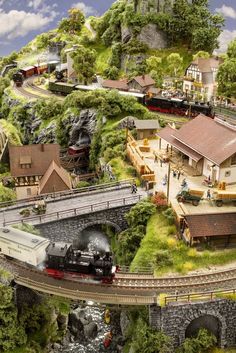No Title
5 Essential Techniques for Crafting Realistic Water Effects in Micro-Scale Model Railroading

Introduction to Scenic Modeling
When we immerse ourselves in the intricate world of micro-scale model railroading, Online Lionel train worth reference we are not just assembling trains and tracks; we're creating entire worlds in miniature. One of the most captivating aspects of these miniature worlds is the representation of water. Realistic water effects can bring a static scene to life, suggesting motion and adding a sense of realism that can transport the viewer to a tiny world as complex and dynamic as our own. Whether it's a serene lake, a flowing river, or a cascading waterfall, achieving a realistic water effect is a skill that elevates the art of scenic modeling.
Mastering Resin Casting for Still Water
Resin casting is a favored method for creating still water effects such as ponds and lakes. The process involves pouring a liquid resin into a prepared area of your model where water is to be depicted. As it cures, the resin hardens to a clear, glossy finish that resembles the smooth surface of still water. To achieve the best results, it's essential to prepare your surface by sealing it properly to prevent the resin from leaking. Adding pigments to the resin can help simulate depth, with darker colors at the center fading to lighter shades near the shores. This gradation mimics the natural appearance of water and adds a layer of depth to your miniature scene.
Creating Water Texture with Acrylic Painting
Acrylic painting is a versatile technique for adding texture and color variation to water surfaces. This method is particularly useful for representing moving water, where the surface is not perfectly smooth. By using a combination of thin glazes Vintage model train valuation guide pdf and dry brushing, we can simulate the appearance of water currents and subtle waves. Acrylics are fast-drying and can be layered to create the illusion of depth and movement. For added realism, consider painting the base layer of the water area with colors that reflect the surrounding environment, such as greens and browns, before adding the final layers of blue and white to represent the water itself.
Ripple Simulation for Dynamic Water Surfaces
Ripple simulation is a specialized technique for depicting water in motion. This involves creating small waves and ripples that suggest the movement of water, be it from a gentle breeze or the current of a stream. To simulate ripples, we can use clear silicone or specialized water-effect products that are applied over the painted water surface. By dragging a small tool, such as a toothpick or a paintbrush handle, through the medium, we create ripples that capture and reflect light, just like real water. This technique requires patience and a steady hand, but the results are well worth the effort, adding a dynamic touch to any water scene.
Scenic Modeling for Realistic Environments
Scenic modeling is the broader https://ask-the-guide.s3.us.cloud-object-storage.appdomain.cloud/news/model-train-tips/creating-lifelike-scenery-for-model-railways-tips-for-backdrops-building.html art of creating realistic environments that complement the water effects in your micro-scale model railroading project. It encompasses the placement of vegetation, rocks, and other natural elements to frame the water feature and integrate it seamlessly into the landscape. When we add these details, we not only enhance the water effect but also create a more believable world. For instance, the careful positioning of rocks and sand along a water's edge can suggest erosion or sediment buildup, while strategically placed foliage https://sfo3.digitaloceanspaces.com/asktheguide/reviews/model-train-tips/what-is-the-difference-between-ho-scale.html can indicate the presence of moisture and the water's impact on the surrounding environment.
Scale Waterfalls: The Pinnacle of Water Modeling
Scale waterfalls are perhaps the most challenging water feature to model convincingly. They require a combination of the aforementioned techniques to simulate the force and energy of falling water. By layering sheets of clear plastic or using cascading resin, we can create the vertical flow of water. Painting the underlying surface to suggest water's froth and turbulence, then adding clear mediums to form the waterfall's mist and splash, brings the scene to life. With careful attention to the way water interacts with rocks and air, a scale waterfall can become the centerpiece of a model railroad landscape. In conclusion, crafting realistic water effects in micro-scale model railroading is an art that combines patience, precision, and a deep understanding of the natural world. By mastering techniques such as resin casting, acrylic painting, ripple simulation, scenic modeling, and the creation of scale waterfalls, we can transform our miniature worlds into captivating scenes that resonate with the beauty of real-life water bodies. Each technique offers its own set of challenges and rewards, and when applied with care and creativity, they contribute to a model railroad display that is both technically impressive and aesthetically stunning.
